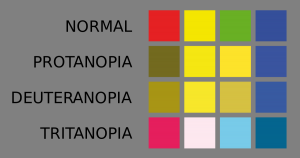Color, Depth, and Size
106 Color Deficiency
Learning Objectives
Be able to describe what color deficiency is.
Understand the difference between true color blindness and color deficiency.
Be able to describe three types of color deficiency: Protanopia, Deuteranopia, and Tritanopia.
True color blindness (the lack of color sensation) is rare. It can be found in rod monochromats (people with only rods) and/or as a result of some brain injuries (color-sensitive blobs are most sensitive to oxygen deprivation). Color deficiency, however, is more common, and results from the lack of one of the cone pigments. The three different types of color deficiency include:
Protanopia: There is no L (long wavelength, or red) pigment. This makes it hard to distinguish between red and green, making reds look particularly dark. This affects a few percent of the male population and a very small fraction of a percent of the female population (since the genes for the cone pigments are located on the X chromosome).
Deuteranopia: There is no M (medium wavelength, or green) pigment. This makes it hard to distinguish between red and green. It affects a few percent of the male population and a tiny fraction of a percent of the female population.
Tritanopia: There is no S (short wavelength) pigment. This makes it difficult to distinguish yellows, greens, and blues. This kind of color deficiency is very rare.
Despite much recent improvement in gene therapy for color blindness, there is currently no FDA approved treatment for any form of CVD (color vision deficiency) , and otherwise no cure for CVD currently exists. Management of the condition by using lenses to alleviate symptoms or smartphone apps to aid with daily tasks is possible.

Watch this video to learn more about colorblindness!
Cheryl Olman PSY 3031 Detailed Outline
Provided by: University of Minnesota
Download for free at http://vision.psych.umn.edu/users/caolman/courses/PSY3031/
License of original source: CC Attribution 4.0
Adapted by: Katherine Hebig

